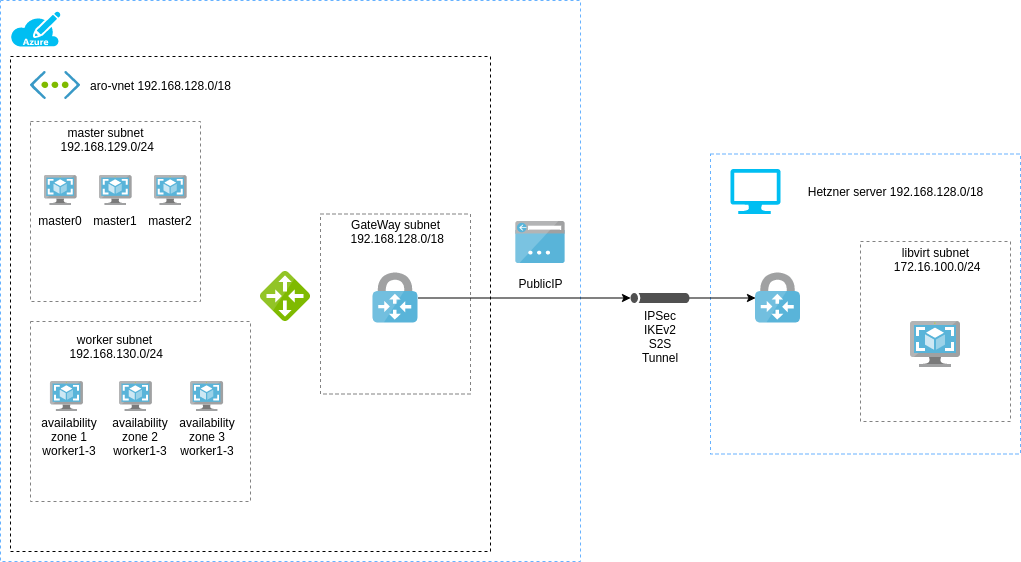Stumbling into Azure Part II: Setting up a private ARO cluster
In Part I of our blog post we covered setting up required resources in Azure. Now we are finally going to set up a private cluster. Private
As review from Part I here is our planned setup, this time including the ARO cluster.
Azure Setup
The diagram below depicts our planned setup:

On the right hand side can see the resources required for our lab:
- a virtual network (vnet 192.168.128.0/19). This vnet will be split into 3 separate subnets
- a master subnet (192.168.129.0/24) holding the ARO control plane nodes
- a node subnet (192.168.130.0/24) holding ARO worker nodes
- and finally a subnet call
GatewaySubnetwhere we are going to deploy our Azure VPN gateway (called avnet-gateway)The subnet where the Azure VPN gateway is located needs to have the name
GatewaySubnet. Otherwise creating the Azure VPN gateway will fail. - we also need a
publicIPresource that we are going to connect to ourvnet-gateway(the VPN gateway) - and finally a
local-gatewayresource that tells thevnet-gatewaywhich networks are reachable on the left, in our case the Hetzner server.
Creating the private Azure Red Hat OpenShift cluster
Register required resource providers
az provider register -n Microsoft.RedHatOpenShift --wait az provider register -n Microsoft.Compute --wait az provider register -n Microsoft.Storage --wait az provider register -n Microsoft.Authorization --wait
First we are going to set some environment variable. Those variables are used in the upcoming commands:
export RESOURCEGROUP=aro-rg export CLUSTER="aro1" export GATWAY_SUBNET="192.168.128.0/24" export MASTER_SUBNET="192.168.129.0/24" export WORKER_SUBNET="192.168.130.0/24" export HETZNER_VM_NETWORKS="10.0.0.0/24 192.168.122.0/24 172.16.100.0/24"Disable subnet private endpoint policies
az network vnet subnet update \ --name master-subnet \ --resource-group $RESOURCEGROUP \ --vnet-name aro-vnet \ --disable-private-link-service-network-policies trueCreate a private DNS zone for our cluster
az network private-dns zone create -n private2.tntinfra.net -g aro-rgCreate the cluster
az aro create \ --resource-group $RESOURCEGROUP \ --name $CLUSTER \ --vnet aro-vnet \ --master-subnet master-subnet \ --worker-subnet worker-subnet \ --apiserver-visibility Private \ --ingress-visibility Private \ --domain private.tntinfra.net # --pull-secret @pull-secret.txt # [OPTIONAL]After successful cluster creating add DNS entry for the API and Ingress
Query the Azure API for the API server IP and the ingress IP addresses:
az aro show -n aro1 -g aro-rg --query '{api:apiserverProfile.ip, ingress:ingressProfiles[0].ip}'Example output
Api Ingress ------------- --------------- 192.168.129.4 192.168.130.254Add entries to Azure private DNS
az network private-dns record-set a add-record -g aro-rg -z private.tntinfra.net -a "192.168.129.4" -n api az network private-dns record-set a add-record -g aro-rg -z private.tntinfra.net -a "192.168.130.254" -n "*.apps"List entries to verify configuration
az network private-dns record-set a list -g aro-rg -z private.tntinfra.netOutput:
Name ResourceGroup Ttl Type AutoRegistered Metadata ------ --------------- ----- ------ ---------------- ---------- api aro-rg 3600 A False *.apps aro-rg 3600 A FalseList cluster credentials after successful setup
az aro list-credentials \ --name $CLUSTER \ --resource-group $RESOURCEGROUPGet the console URL
az aro show \ --name $CLUSTER \ --resource-group $RESOURCEGROUP \ --query "consoleProfile.url" -o tsv
DNS, curl
this works, dunno why?
dig @192.168.129.7 console-openshift-console.apps.xm7rdz4r.westeurope.aroapp.iouse curl to access the internal API and see if it works:
curl -kv https://192.168.129.4:6443Copyright © 2020 - 2025 Toni Schmidbauer & Thomas Jungbauer
Discussion
Comments are powered by GitHub Discussions. To participate, you'll need a GitHub account.
By loading comments, you agree to GitHub's Privacy Policy. Your data is processed by GitHub, not by this website.